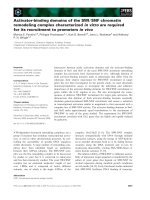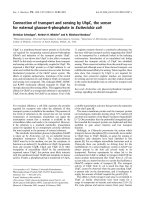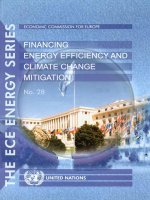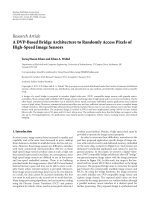English Solutions for Engineering and Sciences Research Writing: A guide for English learners to publish in international journals ppt
Bạn đang xem bản rút gọn của tài liệu. Xem và tải ngay bản đầy đủ của tài liệu tại đây (4.74 MB, 186 trang )
By Adam Turner
English Solutions for Engineering and
Sciences Research Writing:
A guide for English learners to publish in international journals
Director, English Writing Lab
Center for Teaching and Learning
and College of Engineering
Hanyang University, Seoul, Korea
www.hanyangowl.org
02-2220-1612
Version 1.4 December 2009
These materials were designed for engineering and sciences graduate students writing
for publication in English at Hanyang University in Seoul, Korea. However, most of the
material is useful for writing in other fields and for new authors from any language
background. This edition is a work in progress. Some formatting problems remain.
Please use the “bookmarks” function in the upper left panel of the PDF viewer to
view the contents. For instructions see
Readers using this book should also download files on
Computer-assisted writing
Common format and punctuation errors
How to modify the settings of MS Word editing functions
And MS Word skills
Biomedical researchers can download a separate guide to biomedial writing PDF ebook
Terms of use
These materials may be freely distributed for non-commercial purposes under creative
commons license
English:
한글:
If any changes are made to the materials they must also be freely available under this “share
alike” license.
Credit must be given as follows:
2009 HYU CTL English Writing Lab and Adam Turner
Definition of non-commercial use
See for more materials on writing for publication in English
across fields.
Please refer others to the original URL of this PDF file at
:8001/writing/engsciresearchwritingbook.pdf
Suggestions or corrections are welcome:
Preface: How to use this book
Who is this book for?
This book was written primarily for Korean engineering and sciences master’s and Ph.D.
students at Hanyang University in Seoul, Korea writing their first SCI journal article or
conference paper as the primary author. It is also intended to help those students who want to
write their science thesis or dissertation in English. However, even non-native speaking faculty
may benefit from some of the advanced grammar and writing style advice. Although designed
for engineering and sciences, most of the content of the book is useful for writing in other fields.
Students in social sciences using quantitative methods in particular will also find it useful. This
book was not designed for writing in fields such as law, literature, and other humanities.
However, much of the writing advice still applies. Authors in biomedical writing should combine
this one with a specialized text at
Who wrote this book?
It is a project of the Hanyang University Center for Teaching and Learning English Writing Lab
and was written by its current director, Adam Turner. The English Writing Lab offers a free
consulting service to help Hanyang authors publish their research in English, provides
specialized workshops based on original research on writing for publication, and creates
specialized online and print materials to support Hanyang researchers writing across a variety
of fields. See www.hanyangowl.org.
Why was this book written?
This book grew out of my own difficulty in finding a textbook suitable for Hanyang graduate
engineering students. Although there are many books on scientific writing skills, they are mainly
designed for native speakers and usually give only very general advice on writing. Many lack
specific information on the structure and grammar of scientific writing needed by Korean
researchers. Other books designed for non-native speakers tend to be too basic and not give
enough detailed information on paragraph and article structure that is science and engineering
specific. In short, the book was written because I couldn’t find one similar to it.
A second important purpose is to support Hanyang faculty in their efforts to help their graduate
students learn to write in English for publication. In talking to faculty, it was found that a lot of
time is being taken up helping with or correcting students’ basic writing problems when revising
first drafts of articles written by graduate students. It is hoped that the quality of student first
drafts can be improved if students refer to this guide.
The book is also part of our wider strategy to integrate Writing Lab face to face writing
consulting, workshops, print self-study materials, and online interactive materials into an
integrated system to help support Hanyang graduate students, faculty, and researchers to
publish internationally in English. Details on the CTL English Writing Lab consulting service can
be found at the end of this preface.
How is this book different from other books?
1. It is research-based
The book uses insights from research in the fields of Applied Linguistics and English for
Specific Purposes and the emerging field of English for Research Purposes. These research
areas analyze the type of language spoken and written in professional fields like engineering
and medicine. Rather than just giving general English writing advice using instructor intuition,
this book uses research insights from specialized writing journals to improve the material.
2. It is based on computer analysis of authentic texts
All the best practices and examples are directly taken from computer analysis of real published
articles. In looking at authentic text, it was found that some general advice on writing like
“avoiding the passive” or never using “we” does not apply to fields like engineering. In addition,
by only looking at real published papers, some significant differences between fields even
within the same discipline such as engineering were found in terms of article structure and
writing style.
Unlike many other writing books published in Korea, it is not just a collection of example
sentences but combines best practices and frameworks for different sections of the paper, such
as the introduction or abstract, with advanced grammar tips on the specific sentence structures
that are needed for each section of the paper. For example, the grammar to politely but critically
evaluate problems with previous research in the introduction is explained. This book takes a
general approach inspired by Swales and Feak (1994) that combines higher level genre
analysis with grammar support needed for functions in each section of the research article.
3. It is based on a needs analysis of Korean students
Language background and education experience are important factors that influence student
needs. This book is specifically designed to meet the needs of Korean graduate students and
faculty writing in English.
How is this one different from the first edition?
The chapters on computer-assisted writing and common format punctuation errors were
expanded and revised but removed from this book and made into separate files available at
www.hanyangowl.org.
The first edition was based on engineering writing. However, during my research I found that
there were significant differences between fields of engineering, for example, between
computer, chemical, and civil engineering. Indeed papers in some fields like computer
hardware engineering and applied physics were found to have more in common with each other
than with other fields like civil engineering. Therefore, a more general approach to science and
engineering writing was taken in this book. Future revisions will focus on single fields or
research approaches rather than disciplines like engineering or medicine. The fields of English
for Specific, Academic, or Research Purposes are probably overusing the category of
“discipline” for genre and corpus studies and course and materials design.
How to use this book
This book is designed as a self-study guide to help students improve their manuscript before
showing their paper to their advisors or seeking help at a Writing Center. Research studies and
my own experience teaching graduate engineering students has shown that graduate students
are more like busy adult learners than undergraduate students. Self-study materials, study
groups in a lab, or feedback from advisors are the ways graduate students seem to learn rather
than only through traditional writing classes. The CTL Writing Lab at Hanyang was also
designed to help students exactly when they need it most: when they are actually writing their
articles for publication.
A copy of the first book was given to each professor in engineering and natural science
departments at Hanyang University for students to consult the book in the lab while they are
writing. Professors could also assign students who are writing their first draft of a co-authored
article, thesis or dissertation in English to read chapters of the book. In addition, the book
chapters are also being used by study groups organized in a lab and led by a senior student.
There are also writing checklists for each section of the article that students can check while
editing their papers.
Limitations
I recognize that good writing materials and Writing Lab help are only a part of the solution. It is
only the experience of a professor in the field advising a graduate student that can produce the
best co-authored paper. However, the purpose of our materials is only to help raise the quality
of the basic structure and level of English of the manuscript from students writing as the primary
author, so faculty can concentrate more on what they do best: share their knowledge of their
field.
Future plans
We invite faculty and graduate students from all departments to give feedback on this book and
suggestions for materials on English research writing. For example, we have identified the
difficulty of replying to reviewers’ comments and the need for more sentence level grammar
advice as possible topics. Please email with suggestions. To find out
more about our writing consulting services for Hanyang students and faculty please see the
writing lab homepage at and view the description of the service
following this preface.
Acknowledgements
I would like to thank a number of people who have helped to make this book possible. First of
all I would like to thank the CTL staff and especially Professor Yeong Mahn You, Director of the
Center for Teaching and Learning, for recognizing that an innovate writing lab approach was
required to help faculty and graduate students with advanced English writing skills. I would also
like to thank Whoi-Yul Kim, professor of electrical and computer engineering, for giving me the
opportunity to teach a prototype engineering graduate writing course that helped to launch me
in a new career direction. My former and current assistants especially Juekyung Pae, Jung-min
Kim, Tae-kyung Kim, and Soohwan Jung who provided valuable help in formatting and
collecting the data for this book. Finally, my colleague and assistant director of the English
Writing Lab, Jocelyn Graf, provided valuable editing feedback on the first manuscript.
Adam Turner
Director
English Writing Lab
First Print Version February 2007
Current Online PDF Version December 2009









